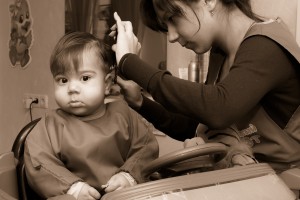Haircuts can be especially nightmarish for children on the autism spectrum. The sensory assault from this experience can overwhelm children and stress out families. The noise of electric clippers, the itchy discomfort of falling hair, the gleam and snip of sharp scissors, and the anxiety of the unknown and unpredictable movements are a frightening combination for many children on the spectrum. This article offers some tips for reducing the stress of haircuts for autistic children through proper preparation and positive reinforcement.
Preparing Your Autistic Child for a Haircut
Preparing your child in advance for the sights, sounds, and atmosphere of a haircut can help reduce the anxiety of what is unknown about the ritual. Below are several tips for doing so:
- Create a social story with pictures or video about the whole experience to review with your child beforehand.
- If you are taking your child to a salon, talk to the salon manager about visiting the salon ahead of time so he can familiarize himself with the atmosphere. Discuss specific accommodations your child will need and how they can make the haircut as successful as possible.
- Practice at home without actually cutting any hair. If you or a stylist will use electronic clippers, allow your child to explore how they work and the sounds they make.
- Watch videos of other children getting haircuts that match the style your child will get.
During the Haircut
How you or your child’s stylist approaches the process can also significantly impact your child’s experience. Consider the following suggestions for facilitating your autistic child’s haircut:
- Speak slowly and softly during all steps of the haircut. Model calm behavior so your child understands there is nothing to be frightened of and that you will keep him safe.
- Always explain what you are going to do each step of the way and what you are currently doing. Don’t make any sudden movements. This will help lessen the fear your child feels due to the unknown activity involved in getting a haircut.
- If you ask questions during the haircut, be patient and wait for a response before you proceed. Don’t make your child feel rushed; this can add to the stress.
- Use reinforcers for different stages of the haircut. Some children will be fine with a simple distraction for the entire process, such as an iPad or a favorite toy. However, others will require additional motivation to remain still. For these children, consider offering different rewards or reinforcers for different phases of the haircut. These could occur after a specific period of time or after a section of the haircut is complete.
- If you or someone you know is cutting your child’s hair at home, make sure to use a cape or towel around their neck to prevent trimmings from irritating the skin. Additionally, have plenty of clean washcloths ready for use on the face if they get hair in their eyes or mouth.
- Be flexible with the process and setting. An understanding stylist may cut hair while lying on the ground with your child, for example. (See how this British barber accommodated for his client)
Relax Your Expectations
Fortunately, getting a haircut isn’t the most important of self-care skills. Certainly there are benefits to maintaining your hair with regular cuts, but it’s okay to be relaxed in this area, especially if your child is easily overwhelmed by the process.
If you are a parent of a child on the spectrum, you’ve probably already learned that it is easier to lower your style expectations than to enforce a strict or complex hair maintenance regimen. If your child has hair that looks nice with a longer style and can be easily maintained, allow them to grow it out. If longer hair is a nuisance or even a safety concern, opt for a simple style that can be cut quickly and is easily maintained.
After the Haircut
After the haircut is over, emphasize the benefits your child will now receive with a fresh look. You could talk about how handsome or clean they look. You also might mention how nice it will be to spend less time washing their hair, or how much better it will feel to not have their hair hanging in their eyes. This calls attention to the purpose of the haircut and asks your child to notice the difference.
Ask your child to reflect on the process, if possible. What was especially difficult for them? What techniques were helpful? What can you do in the future to make the experience even more successful? Let your child know that you want their input into planning the next haircut and you want to support them in whatever ways you can.
Additional Resources About Haircuts for Autistic Children
http://www.people.com/article/james-williams-mason-autism-haircut
https://www.autismspeaks.org/family-services/tool-kits/tips-successful-haircuts
http://www.healthcentral.com/autism/c/1443/161112/children-meltdowns-haircuts/

